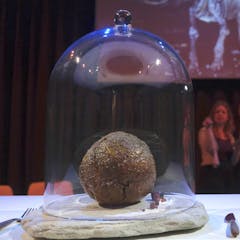
Articles on Cultured meat
Displaying 1 - 20 of 22 articles

Cultured meats, precision fermentation and other cutting-edge technologies are predicted to disrupt conventional agriculture. Despite the threat, New Zealand is well positioned to ride the wave.

Cell cultures are common tools in biology and drug development. Bringing them up to scale to meet the meat needs of societies will require further development.

Lab-grown meat seems green, ethical and quirky – but at industrial scale, it’s likely to cause unforeseen problems.

Growing meat in vats could help us prepare for climate change - and curb the environmental damage done by traditional meat. But only if we can scale it up.

A new ‘protein roadmap’ produced by CSIRO reveals foods set to fill fridges by 2030 as health, environmental and ethical concerns push consumers away from meat.

Plus, new research from Indonesia on the relationship between cigarette advertising near schools and children smoking.

Singapore has approved ‘chicken bites’ containing meat grown in vitro. But not all animal advocates are happy about this.

The Singapore Food Agency has approved US food company Eat Just’s cultured ‘chicken bites’ for sale.

The end of factory farming will lay the foundation for a rural resurgence and the development of more just and sustainable communities for people and animals alike.

If lab-grown meat is truly going to be the next frontier in ethical eating, it’s important to consider who’s most at risk of being left behind in the race to develop it.

Awareness is increasing about foods like lab-grown meat, insects and seaweed. These foods may help address environmental challenges, but it’s important to be aware of both the costs and benefits.

According to some, meat “grown” in a laboratory would only have advantages: an end to animal abuse, preservation of the environment… But the reality is less idyllic.

It’s relatively easy to grow a bunch of animal cells to turn into a burger. But to grow a steak made of cultured meat is a trickier task. Bioengineers must create organized, three-dimensional tissues.

Surveys suggest fewer than half of Americans are looking forward to lab-grown meat. A moral psychologist examines common objections and why for the most part they’re not logical.

As the number of companies growing meat in vats explodes, the sector is facing challenges that show it is coming of age.

Despite many claims, nobody knows for sure how the environmental footprint of lab-grown meat compares to livestock. An animal scientist says the issue is not black and white.

Cultured meat comes from cells in a lab, not muscles in an animal. While regulatory and technological aspects are being worked out, less is known about whether people are up for eating this stuff.

We need to address the mindset that enables this mass slaughter of animals in the first place.

We might be able to grow artificial meat but are people really prepared to eat such produce over meat from farmed animals?

The launch of the lab-bred “meat” in London was a masterly act of timing, theatre, and media management. But now that rabbit is out of the hat, there are questions that need to be asked, and answers that…
